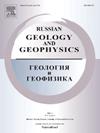青藏高原东北部祁连山的活动构造变形
IF 1.2
4区 地球科学
Q3 GEOSCIENCES, MULTIDISCIPLINARY
引用次数: 0
摘要
-祁连山(或称祁连山)位于青藏高原的东北边缘,是印度-欧亚大陆碰撞远场影响下形成的一个活跃的造山带。印度板块的向北渗透是造成祁连山地壳强烈缩短的原因。然而,地壳缩短所引起的构造变形模式仍不清楚。在本研究中,我们根据过去二十年的历史数据,展示了区域地震活动、断层活动和 GPS 地壳运动速度场,以描述祁连山活动构造变形的特征。结果表明,祁连山西部以分布式南北向地壳缩短为特征,而祁连山东部则以块状地壳沿主要走向滑动断层向东挤压为主,并伴有顺时针旋转。南北向地壳缩短和东西向横向挤压是印度-欧亚大陆汇聚的两种变形模式,与祁连山的地壳变形相吻合。祁连山西部的构造变形与前者基本一致,而祁连山东部则与后者密切相关。青藏高原中部下方的低地壳流动为地壳物质向东挤出青藏高原和一些边界山脉(如祁连山)的形成提供了潜在的动力。本文章由计算机程序翻译,如有差异,请以英文原文为准。
Active Tectonic Deformation of the Qilian Shan, Northeastern Tibetan Plateau
—The Qilian Shan (or Qilian Mountains), located on the northeastern margin of the Tibetan Plateau, is an actively growing orogenic belt resulting from the far-field impact of the India–Eurasia collision. The northward penetration of the Indian Plate is responsible for intense crustal shortening in the Qilian Shan. However, the tectonic deformation pattern in response to the crustal shortening remains unclear. In this study, we present the regional seismicity, fault activity, and GPS crustal movement velocity field to characterize the active tectonic deformation of the Qilian Shan based on historical data over the past two decades. The results suggest that the western Qilian Shan is characterized by distributed north–south crustal shortening, while the eastern Qilian Shan is dominated by blocklike eastward extrusion of crust along major strike-slip faults coupled with clockwise rotation. North–south crustal shortening and east–west lateral extrusion, two deformation modes responding to the India–Eurasia convergence, match the crustal deformation in the Qilian Shan. The tectonic deformation of the western Qilian Shan is largely in agreement with the former, while the eastern Qilian Shan corresponds closely to the latter. Lower crustal flow beneath the central Tibetan Plateau provides the potential driving force to induce the eastward extrusion of crustal material out of the plateau and the growth of some boundary mountain ranges, such as the Qilian Shan.
求助全文
通过发布文献求助,成功后即可免费获取论文全文。
去求助
来源期刊

Russian Geology and Geophysics
地学-地球科学综合
CiteScore
2.00
自引率
18.20%
发文量
95
审稿时长
4-8 weeks
期刊介绍:
The journal publishes original reports of theoretical and methodological nature in the fields of geology, geophysics, and geochemistry, which contain data on composition and structure of the Earth''s crust and mantle, describes processes of formation and general regularities of commercial mineral occurrences, investigations on development and application of geological-geophysical methods for their revealing. As to works of regional nature, accelerated publication are available for original papers on a variety of problems of comparative geology taking into account specific character of Siberia, adjacent Asian countries and water areas. The journal will also publish reviews, critical articles, chronicle of the most important scientific events, and advertisements.
 求助内容:
求助内容: 应助结果提醒方式:
应助结果提醒方式:


